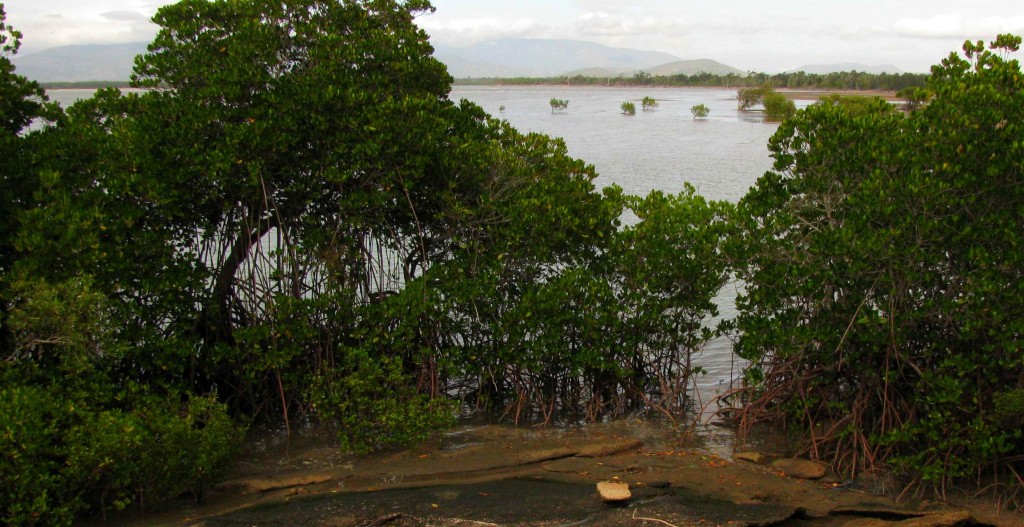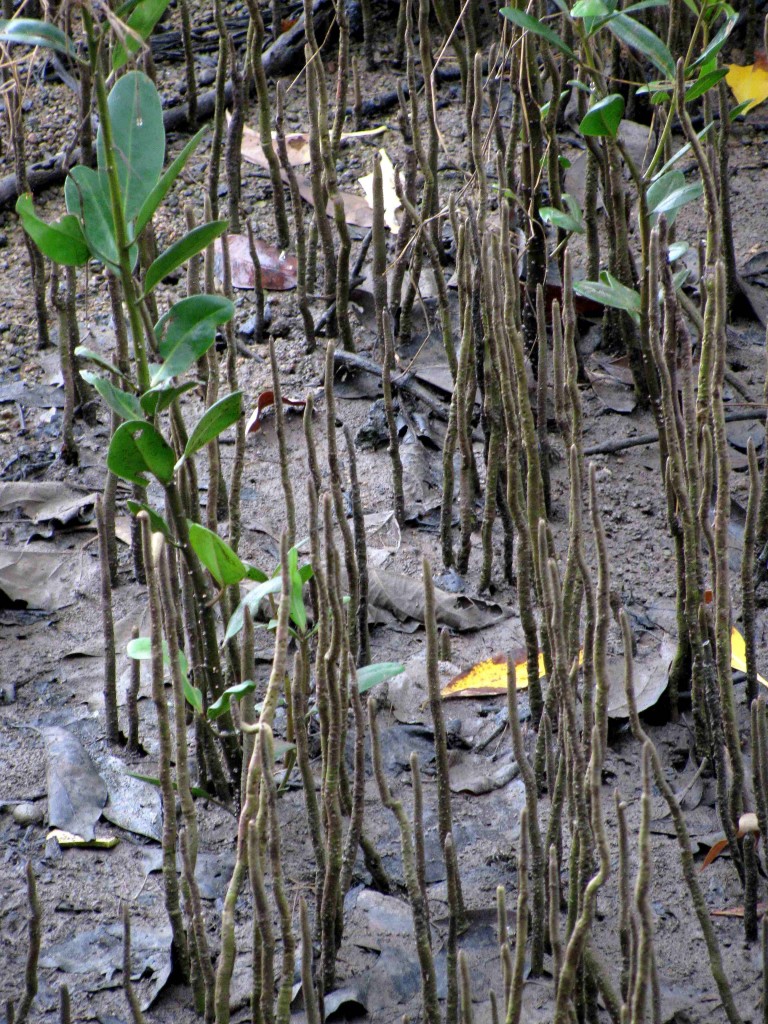
Mangroves at Chunda Bay, Bowling Green Bay National Park (© Magi Nams)
It was a week after our arrival in Australia that Vilis and I realized that the short, densely-foliaged trees forming tangled borders along the Ross River and Ross Creek, beside which we walked or ran or skated every day, were in fact mangroves. They proclaimed their identity not by leaves or trunks or bark, but by their roots, which poked up through the intertidal mud as spikes or formed variously-shaped props.
‘Mangrove’ is a general term referring to woodlands or forests growing in the intertidal zone of a coast, that is, in the strip of shoreline covered and uncovered by ocean tides.1 Mangroves are most commonly found in tropical and subtropical climes, although some occur in temperate regions.2 They occupy sheltered shorelines, estuaries, and tidal rivers as far upstream as salt water reaches.1 Florida’s Everglades are a famous mangrove ecosystem in the Northern Hemisphere.
In Australia, mangroves are important components of coastal vegetation in the country’s northern tropics, as well as extending as far south as northern Victoria.2 The distribution of mangroves is very much influenced by temperature, with the occurrence of frosts thought to limit their geographical range in this country.2 The amount of rainfall also determines the size and diversity of mangrove forests.2 Australia’s most diverse mangroves occur practically next door in the Ingham–Innisfail region.2 The most extensive examples of this type of vegetation occur on the east side of Cape York Peninsula.2 Both of these regions lie within Australia’s wet tropics zone.2
Because mangroves grow in the intertidal, they must cope with a number of environmental stresses, including waterlogged soil, high salinity, low oxygen, wave disturbance, radical temperature shifts, silt deposits, and poisonous gases produced in the muddy substrate.3 They combat these stresses by producing aboveground roots to exchange gases, by filtering, excreting or accumulating salt, by extending a network of shallow cable roots through the soil to stabilize it,3 by growing thick, waxy, water-conserving leaves,4 and by producing buoyant seeds3 that may float to a suitable germination site.

Mangrove Stilt Roots, Crystal Creek (© Vilis Nams)
The intriguing aboveground roots of mangroves assume several distinct forms – looping prop roots called stilt roots, peg-like roots called pneumatophores that protrude upward from cable roots, knee roots that resemble bent knees and are loops in cable roots, buttress roots that are blade-like supports, and aerial roots that drop from branches but never enter the soil.5 The type of aboveground roots a mangrove species possesses is thought to be related to the species’ location with respect to the land elevation and the degree of inundation by the tide. 6
I’ve noticed, as have many others, no doubt, that mangroves seem to grow in parallel bands that trace shoreline contours, some closer to the water’s edge and some farther from it. Mangrove forests are generally divided into three zones: the outer zone, the middle or main zone, and the landward zone, also called the littoral fringe.6 The outer zone is most exposed to the ocean or tidal river, whereas the landward zone may merge into salt-intolerant forest.6
Mangroves are rich treasure houses of biological diversity, providing habitat for marine animals such as crabs, snails, fish, and sea snakes, as well as the saltwater crocodile. Many birds forage on mangrove mudflats at low tide, and flying foxes and other bats roost in mangroves during the day.7 During an early-morning outing on Townsville’s oceanfront Esplanade, I observed mangrove gerygones and varied honeyeaters singing and foraging within the band of mangroves bordering Rowe’s Bay. Australian white ibises and squabbling flying foxes roosted in the tangle of short, densely-leaved mangroves, and a Brahminy kite circled overhead, no doubt scouting for an exposed bat or other prey. The trees appeared part of both land and sea, a bridge linking the life of two worlds.

Mangrove Peg Roots or Pneumatophores, Ross River (© Magi Nams)
References:
1. Dave Claridge and John Burnett. Mangroves in Focus. 1993. Wet Paper, Ashmore, Queensland, p. 2.
2. R.W. Galloway. Distribution and Physiographic Patterns of Australian Mangroves. In: B.F. Clough, editor. Mangrove Ecosystems in Australia: Structure, function and management. 1982. Australian National University Press, Canberra, p. 32.
3. Claridge and Burnett, pp. 6-8.
4. P. Saenger. Morphological, Anatomical and Reproductive Adaptations of Australian Mangroves. In: B.F. Clough, editor. Mangrove Ecosystems in Australia: Structure, function and management. 1982. Australian National University Press, Canberra, p. 153.
5. Claridge and Burnett, pp. 7-8; 6. Ibid, pp. 9-13; 7. Ibid, pp. 17-19.


